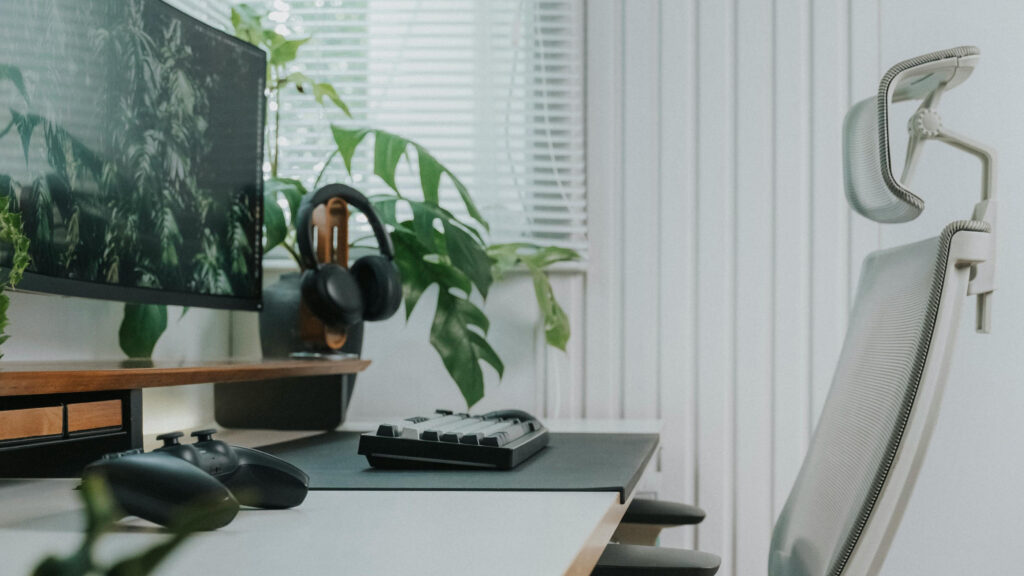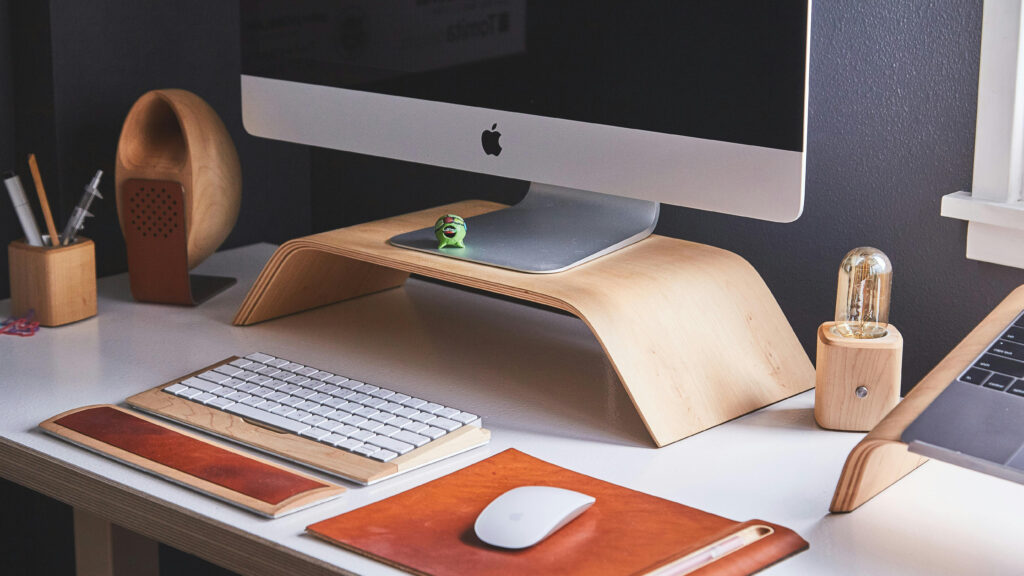Work-from-home budget is crucial as we step into a new year. Starting a new year is a great time to take control of your money if you work from home. Making a good work-from-home budget is more than saving money. It’s about living better and less stressed in 2025. A smart budget helps you handle remote work costs, set up a great home office, and work better.
With a few easy steps, you can make a budget that fits your life. Saving money automatically, checking your subscriptions, and planning meals can save you cash. Using cash for budgeting and using tax refunds wisely also helps your finances. With some planning, your home office can be both productive and affordable.
A cozy home office setup featuring a desk with a laptop, budgeting tools like a calculator and notepads, a cup of coffee, and a plant, surrounded by soft natural light coming through a window, emphasizing a sense of productivity and financial mindfulness.
When making your work-from-home budget, think about the 50/30/20 rule. It suggests spending about 50% on needs, 30% on wants, and 20% on savings and debt. Sticking to this rule and your budget can make you financially stable and less stressed. Always check and tweak your budget to make sure it’s right for you.

Key Takeaways
- Creating a work-from-home budget can help you manage remote work expenses and increase productivity
- Automating savings and auditing subscriptions can help you save money and reduce financial stress
- Planning meals and using cash envelopes for budgeting can contribute to your long-term financial stability
- The 50/30/20 rule can help you allocate your income effectively and achieve financial stability
- Regularly reviewing and adjusting your budget can help you stay on track and achieve your financial goals
- A well-planned work-from-home budget can help you optimize your home office setup and reduce remote work expenses
- By implementing simple strategies, you can create a work-from-home budget that works for you and helps you achieve financial stability
Work-from-Home Budget Framework: Setting Up Your Plan
When you start working from home, setting up a remote work budget is key. It should cover all your home office expenses. This plan helps you find ways to save money and use your budget wisely. Start by listing your must-haves, like a good computer, internet, and a comfy workspace.
Tracking your remote work budget is crucial. You need to watch your monthly costs. This includes things like rent, utilities, and things you buy for your office. Keeping an eye on your spending helps you decide where to spend your money and make changes when needed.
- Identify your fixed and variable home office expenses
- Set up a spreadsheet or use an accounting software to track your expenses
- Regularly review and update your budget to ensure you’re staying on track
Having a solid remote work budget and a way to track your expense tracking system is vital. It helps you manage your home office expenses well. This way, you can keep your finances stable while working from home.
Smart Equipment Investment Strategies for Remote Workers
As a remote worker, getting the right home office equipment boosts your productivity and comfort. There are many choices, so picking wisely is key. Look into remote work tools like a comfy chair, a dependable laptop, and a top-notch webcam.
When picking investment strategies for your home office, go for energy-saving gear. It cuts down on bills and helps the planet. For example, the Herman Miller Embody chair is great for back support. The Acer Chromebook Plus Spin 714 is also a top pick, with a 9/10 WIRED rating.
Also, think about getting a standing desk, like the Generation Chair by Knoll. It’s comfy, adjustable, and affordable. A well-set-up home office can make you 35 to 40 percent more productive. It’s a smart investment.
Don’t forget about other key remote work tools like a VPN, antivirus, and a secure password manager. They keep your data safe and your work environment secure. With a smart plan and the right home office equipment and remote work tools, you’ll have a great space to work from home.
Work-from-Home Budget: Maximizing Tax Deductions for Your Home Office
If you work from home, you can lower your taxes. You can deduct expenses like mortgage interest and utilities, as long as your home office is used exclusively for work.
There are two ways to figure out your home office deduction. The simplified method lets you deduct $5 per square foot, up to 300 square feet, for a maximum deduction of $1,500. The actual expense method requires adding up all your home office costs.
To save on taxes, keep detailed records of your business expenses. Use apps like MileIQ to track your work miles. A tax advisor can help you understand the rules and ensure you get all the deductions you’re eligible for.
Here are some expenses that may be deductible:
- Utilities such as electricity, gas, and water
- Repairs and maintenance, such as plumbing and electrical work
- Depreciation of office equipment
- Rent, if you are a renter
By knowing about home office tax deductions and keeping good records, you can lower your taxes and save more money.
Energy-Efficient Solutions to Reduce Utility Costs
When setting up your home office, think about energy-efficient solutions to cut down on utility costs. The average American uses about 1000 kWh of electricity each month. Simple changes can make a big difference in your energy bills. For example, lowering your water heater from 140 degrees to 120 degrees can save 4%-22% on energy costs each year.
Here are some tips for making your home office setup more energy-efficient:
- Switch to LED lighting to save around $225 a year by replacing incandescent bulbs.
- Get a smart power strip to turn off electronics in standby mode when not in use.
- Choose energy-efficient appliances, like a dishwasher with the EPA’s Energy Star label. It uses 12% less energy and 30% less water than regular models.
By using these energy-efficient solutions, you can lower your utility costs and make your home office setup more eco-friendly. Every little change helps, and it can make a big difference in your energy bills and the planet.
Budget-Friendly Ergonomic Workspace Solutions
Creating an ergonomic workspace is key for remote workers to boost productivity and comfort. Moreover, you can find affordable solutions that meet your needs. An ergonomic workspace helps prevent issues like carpal tunnel and computer vision syndrome. To make your space comfy, try DIY improvements like adjusting your desk to 28-30 inches from the floor.
Furthermore, there are affordable ergonomic furniture options like standing desks, task chairs, and accessories. For example, the Paxton task chair and the Flexure desk are great for a dynamic setup. Additionally, the Rossi workstation and Oscar drawer unit offer compact storage. Lastly, the Polka shelving system is also adaptable and customizable.
- Switch from sitting to standing every half hour to maintain circulation and provide rest to your body
- Invest in a laptop stand to raise your screen to eye level
- Use a keyboard tray to keep your keyboard and mouse at a comfortable height
By making these DIY improvements and buying affordable ergonomic gear, you can make a comfy and efficient workspace. Remember, your health and productivity depend on a well-designed ergonomic workspace.
Technology Cost-Cutting Without Sacrificing Productivity
As a remote worker, you can cut costs by using technology cost-cutting strategies. Start by optimizing your productivity tools and remote work software. This way, you can use your technology more wisely and save resources.
Consider renegotiating with vendors, canceling unused software licenses, and combining your IT services. West Monroe found that using multiple cloud services can lower IT costs. EY Americas also suggests cutting IT services spend by 15% to 30% through smart analysis.
Here are some key strategies for technology cost-cutting:
- Optimize your cloud services to reduce operational costs
- Rename your contracts with vendors to secure better rates
- Implement a remote work software solution that integrates multiple tools and functions
By following these tips, you can lower your tech costs without hurting your productivity. Always check your IT spending to avoid wasting money on unused software and services, as Vineet Arora from WinWire advises. With the right steps, you can save a lot and focus on adding value to your business.
Work-from-Home Budget: Optimizing Subscriptions for Remote Work
If you work remotely, you use many tools and software to stay on top of your game. However, managing these subscriptions can be a big headache. Indeed, it’s easy to spend too much on things you don’t really need. To make your monthly subscriptions work better, take a close look at what you’re using.
Firstly, start by figuring out which tools are must-haves for your job. Then, look for deals that bundle several tools together at a lower price. Additionally, you might also find free versions of popular tools or open-source software to save money.
By following these tips, you can cut down on your expenses. Make it a habit to check your subscriptions often. This way, you’ll always know you’re getting the best value from your tools and software bundle deals.

Conclusion: Building Long-Term Financial Sustainability in Your Home Office
Building a sustainable home office is crucial for your success as a remote worker. By applying the strategies shared in this article, you can save money while contributing to a healthier environment. This setup will not only benefit your finances but also enhance your long-term productivity.
Start by investing in energy-efficient equipment and considering solar power to reduce energy bills. Additionally, using free tools and managing subscriptions effectively can further lower your monthly expenses. This way, you can maintain productivity without overspending.
Financial sustainability goes beyond cutting costs—it’s about creating a workspace that supports your health and focus. With ergonomic solutions and a distraction-free environment, as highlighted on Ergonew, you’ll experience better performance and greater satisfaction.
Keep improving your home office over time. Seek ways to optimize your setup and adjust your plans when necessary. Ultimately, by prioritizing long-term financial and well-being goals, you’ll establish a home office that fosters both career success and personal well-being.
